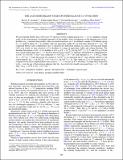THE LAST EIGHT-BILLION YEARS OF INTERGALACTIC C IV EVOLUTION
Author(s)
Cooksey, Kathy; Thom, Christopher; Prochaska, J. Xavier; Chen, Hsiao-Wen
DownloadCooksey-2010-THE LAST EIGHT-BILLI.pdf (2.024Mb)
PUBLISHER_POLICY
Publisher Policy
Article is made available in accordance with the publisher's policy and may be subject to US copyright law. Please refer to the publisher's site for terms of use.
Terms of use
Metadata
Show full item recordAbstract
We surveyed the Hubble Space Telescope UV spectra of 49 low-redshift quasars for z < 1 C IV candidates, relying solely on the characteristic wavelength separation of the doublet. After consideration of the defining traits of C IV doublets (e.g., consistent line profiles, other associated transitions, etc.), we defined a sample of 38 definite (group G = 1) and five likely (G = 2) doublets with rest equivalent widths Wr for both lines detected at $\ge 3\sigma _{W_{r}}$. We conducted Monte Carlo completeness tests to measure the unblocked redshift (Δz) and co-moving path length (ΔX) over which we were sensitive to C IV doublets of a range of equivalent widths and column densities. The absorber line density of (G = 1+2) doublets is ${d}\mathcal {N}_{\mathrm{C\,IV}}/{d}X= 4.1^{+0.7}_{-0.6}$ for log N(C+3) ≥ 13.2, and ${d}\mathcal {N}_{\mathrm{C\,IV}}/{d}X$ has not evolved significantly since z = 5. The best-fit power law to the G = 1 frequency distribution of column densities $f(N(\mathrm{C}^{+3})) \equiv k(N(\mathrm{C}^{+3})/N_{0})^{\alpha _{N}}$ has coefficient k = 0.67+0.18 –0.16 × 10–14 cm2 and exponent α N = –1.50+0.17 –0.19, where N 0 = 1014 cm–2. Using the power-law model of f(N(C+3)), we measured the C+3 mass density relative to the critical density: $\Omega _{\mathrm{C}^{+3}}= (6.20^{+1.82}_{-1.52}) \times 10^{-8}$ for 13 ≤ log N(C+3) ≤ 15. This value is a 2.8 ± 0.7 increase in $\Omega _{\mathrm{C}^{+3}}$ compared to the error-weighted mean from several 1 < z < 5 surveys for C IV absorbers. A simple linear regression to $\Omega _{\mathrm{C}^{+3}}$ over the age of the universe indicates that $\Omega _{\mathrm{C}^{+3}}$ has slowly but steadily increased from z = 5 → 0, with ${d}\Omega _{\mathrm{C}^{+3}}/ {d}t_{\rm age} = (0.42\pm 0.2)\times 10^{-8}\,{\rm Gyr}^{-1}$.
Date issued
2010-01Department
MIT Kavli Institute for Astrophysics and Space ResearchJournal
Astrophysical Journal
Publisher
Institute of Physics/American Astronomical Society
Citation
Cooksey, Kathy L., Christopher Thom, J. Xavier Prochaska, and Hsiao-Wen Chen. “THE LAST EIGHT-BILLION YEARS OF INTERGALACTIC C IV EVOLUTION.” The Astrophysical Journal 708, no. 1 (December 15, 2009): 868–908. © 2009 American Astronomical Society.
Version: Final published version
ISSN
0004-637X
1538-4357